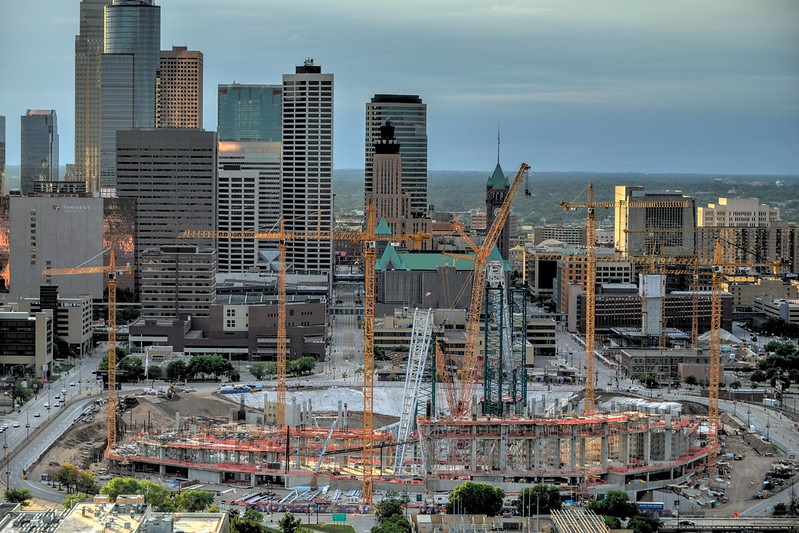
Image Credit: August Schwerdfeger (CC BY 2.0)
It was announced two months ago the U.S. Bank had purchased the naming rights for the new Minnesota Vikings football stadium. The agreement will span 25 years and is believed to be in excess of $200M. This is a positive considering the stadium's construction costs will exceed $1B dollars by the time it is completed in 2016 making it the most expensive construction in the state's history. The Minnesota Vikings and U.S. Bank have wasted no time in attracting big acts to the Twin Cities. The venue is already scheduled to host the 2018 Super Bowl and the 2019 Men's NCAA Final Four and that's only the beginning.
Let's not pretend like the Minnesota Vikings didn't need a new stadium. Who remembers when the snowstorm that collapsed and destroyed the roof of the old Hubert Humphrey Metrodome? Who remembers how terrible watching Minnesota Twins baseball games at the Metrodome were? The Minnesota Twins finally got their own home, Target Field, in 2010 which is adjacent to U.S. Bank Stadium. When the Minnesota Vikings' lease with the Metrodome expired in 2013, they bolted for TCF Bank Stadium as a temporary home which is also home to the Minnesota Gophers football team. TCF Bank Stadium is an outdoor venue, something the Minnesota Vikings ownership lobbied for in the beginning. Both the state and city governments refused to contribute any public dollars for an outdoor football stadium.
Ultimately, the funds needed for the construction of U.S. Bank Stadium have been well provided across the board, however. Often when new stadiums and arenas are constructed, the taxpayers foot the majority of the bill and the team's owners threaten to move the team to another city if there is opposition. The state of Minnesota, the Vikings organization and their investors are covering more than 80% of the stadium's construction costs. HKS Architects, a Dallas firm that designed both Guaranteed Rate Field and Miller Park, have plans to make U.S. Bank Stadium one of the most eclectic and eye catching venues in all of professional sports.
Among the many features of U.S. Bank Stadium will be it's stationary roof. Not since the Detroit Lions opened Ford Field in 2002 has a stationary roof been built in the National Football League. The roof will allow for plenty of natural sunlight to enter the stadium and is steeply slanted in a way that makes snow accumulation difficult. Like Lucas Oil Stadium and Marlins Park, there will be large retractable windows in the end zone that will allow for natural air flow through the stadium. The windows will also allow for breathtaking views of the downtown Minneapolis skyline.
Most importantly is how the noise will be a factor which contributes to the Vikings' home field advantage. The crowd noise will be louder at U.S. Bank Stadium due the material the roof is made out of; the Metrodome roof, on the other hand, was made out of teflon. The new ETFE material will make the acoustics very reflective which means the crowd noise will be deafening when the stadium is at capacity.
Perhaps my favorite feature of the new stadium is the colored glow lights than will be used to light up the stadium's interior at night time when the stadium is empty. The installment of the stadium seats will begin early next week. The scoreboards are expected to be completed come January, 2016 and the grass will finally be installed next May before the Vikings open mini camp. Fans inquiring about becoming Minnesota Vikings season ticket holders for the 2016 season can obtain season ticket information at USBankStadium.com.
Related Articles
- Why do Minnesota Vikings fans chant "Skol"?
- Minnesota Vikings Out $70K After Luxury Suite Scam At U.S. Bank Stadium
- Hotels Near U.S. Bank Stadium
- Breakdown of the Minnesota Vikings Seating Chart
- Minnesota Vikings Hotels on the Road
- Minnesota Vikings Bringing Blackout Curtains To U.S. Bank Stadium
- Sports Bars near U.S. Bank Stadium

